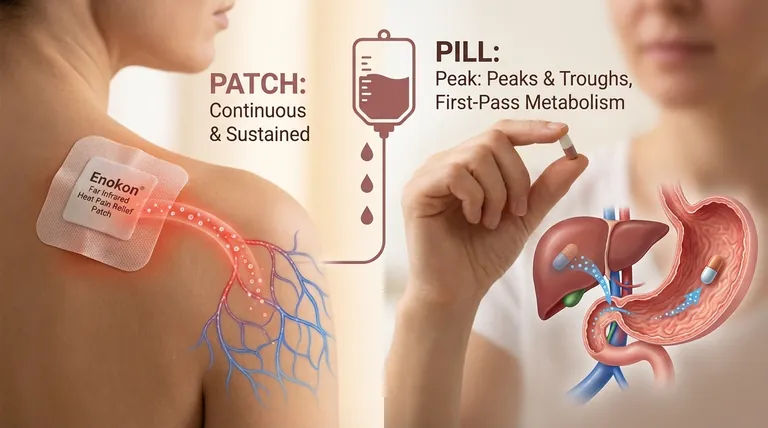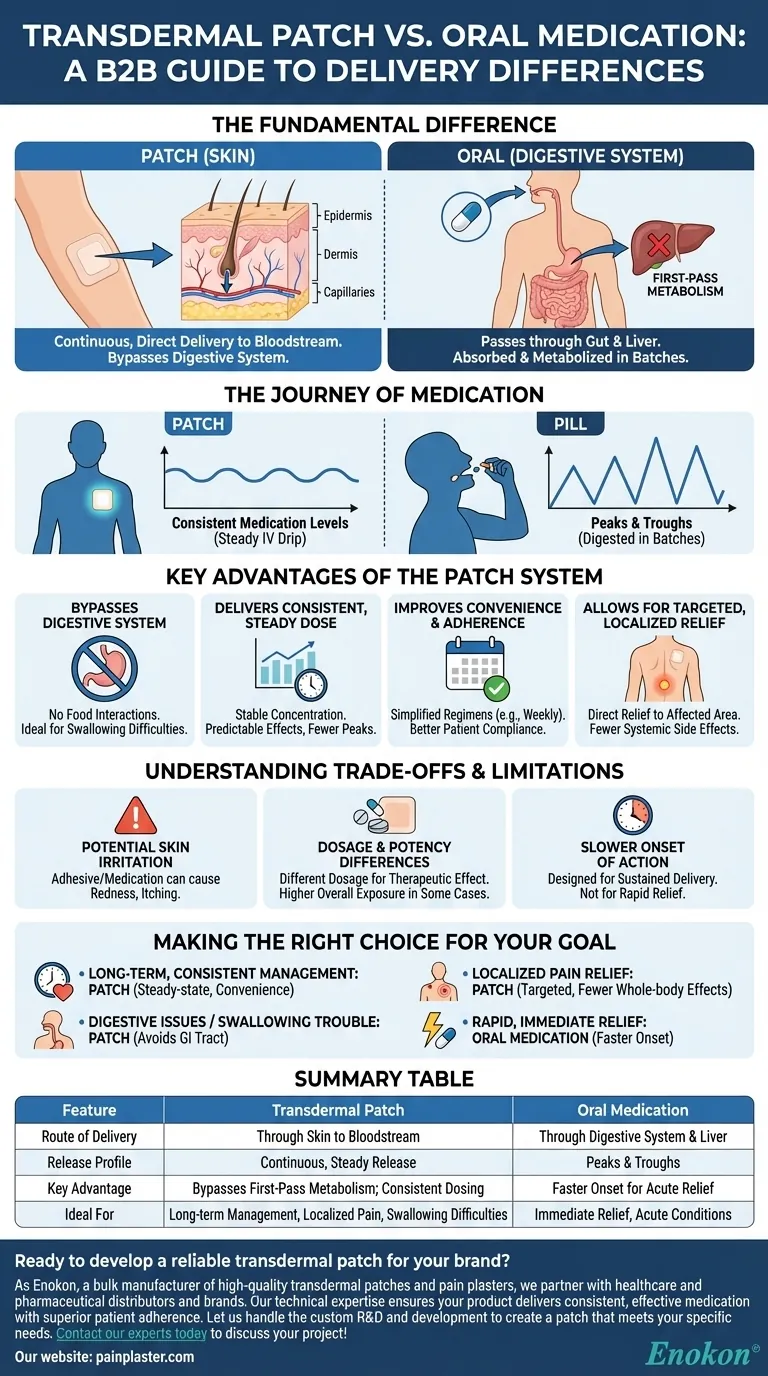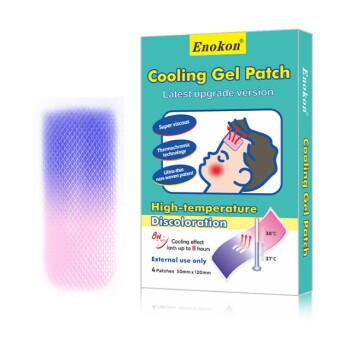The fundamental difference is the path the medicine takes to enter your body. A patch delivers medication continuously through the skin directly into the bloodstream, whereas an oral medication must first pass through the entire digestive system before it can be absorbed.
The core distinction lies in control and consistency. A transdermal patch acts like a slow, steady IV drip, maintaining consistent medication levels, while an oral pill often creates peaks and troughs as it's digested and metabolized in batches.

The Journey of Medication: Patch vs. Pill
To understand the practical implications, it's essential to visualize the two distinct routes the active ingredients take to reach their target.
The Transdermal Route (The Patch)
A patch is applied directly to the skin. It uses a special membrane to release a controlled amount of medication that is absorbed through the skin layers and directly into the capillaries of the bloodstream.
This method provides a continuous and sustained release over a long period, which can range from several hours to multiple days depending on the specific product.
The Oral Route (The Pill)
An oral medication is swallowed and travels through the stomach and intestines. Here, it is broken down and absorbed into the blood vessels that lead first to the liver.
This process, known as "first-pass metabolism," means the liver filters and breaks down a portion of the drug before it ever reaches the rest of the body. This can significantly reduce the amount of active medication that enters general circulation.
Key Advantages of the Patch System
Bypassing the digestive system is not just a different route; it creates several distinct advantages for specific situations and medical conditions.
Bypasses the Digestive System
Because the medicine doesn't enter the stomach or intestines, patches eliminate concerns about food interactions or the need to schedule doses around meals.
This also makes them an ideal solution for individuals with swallowing difficulties or gastrointestinal conditions that might interfere with the absorption of oral drugs.
Delivers a Consistent, Steady Dose
Unlike pills, which can cause spikes and drops in medication levels, the patch delivers a steady, controlled dose. This maintains a more stable concentration of the drug in the bloodstream.
This consistency can lead to more predictable effects and potentially reduce side effects associated with the high "peaks" of oral dosing. For example, some patches provide efficacy for up to 10 hours, while others, like the scopolamine patch, can last for 72 hours.
Improves Convenience and Adherence
Remembering to take a pill every day, or multiple times a day, can be challenging. A patch that is applied weekly, like some contraceptives, or every few days drastically simplifies the regimen.
This improved convenience often leads to better patient compliance, ensuring the medication is taken as prescribed for maximum effectiveness.
Allows for Targeted, Localized Relief
For conditions like back pain, a medicated patch can deliver relief directly to the affected area. This localized treatment minimizes the amount of medication circulating throughout the rest of the body.
This often results in fewer systemic side effects compared to an oral pain reliever that affects the entire body.
Understanding the Trade-offs and Limitations
While effective, the patch delivery system is not a universal solution and comes with its own set of considerations.
Potential for Skin Irritation
The adhesive and the medication itself can cause redness, itching, or irritation at the application site for some individuals. This is one of the most common side effects of transdermal patches.
Dosage and Potency Differences
Because the patch bypasses the liver's first-pass metabolism, the dosage required to achieve a therapeutic effect can be very different from an oral medication.
In some cases, this can also lead to higher overall exposure to certain hormones. For example, some contraceptive patches are known to expose the body to higher levels of estrogen than typical birth control pills.
Slower Onset of Action
Patches are designed for sustained, long-term delivery, not rapid relief. An oral medication is often absorbed more quickly, making it a better choice for acute conditions where immediate effects are needed.
Making the Right Choice for Your Goal
The decision between a patch and an oral medication depends entirely on the condition being treated, your personal health profile, and your lifestyle.
- If your primary focus is long-term, consistent management: A patch is often superior due to its steady-state delivery and improved convenience, which helps with adherence.
- If you have digestive issues or trouble swallowing pills: The patch is a clear winner, as it completely avoids the gastrointestinal tract.
- If your primary focus is localized pain relief: A medicated patch can target the source of pain directly with fewer whole-body side effects.
- If you need rapid, immediate relief for an acute issue: An oral medication will typically work faster than a patch designed for slow release.
Understanding these fundamental differences in delivery empowers you to have a more informed discussion with your healthcare provider about the best treatment path for your specific needs.
Summary Table:
| Feature | Transdermal Patch | Oral Medication |
|---|---|---|
| Route of Delivery | Through the skin into the bloodstream | Through the digestive system and liver |
| Release Profile | Continuous, steady release | Peaks and troughs |
| Key Advantage | Bypasses first-pass metabolism; consistent dosing | Faster onset for acute relief |
| Ideal For | Long-term management, localized pain, swallowing difficulties | Immediate relief, acute conditions |
Ready to develop a reliable transdermal patch for your brand?
As Enokon, a bulk manufacturer of high-quality transdermal patches and pain plasters, we partner with healthcare and pharmaceutical distributors and brands. Our technical expertise ensures your product delivers consistent, effective medication with superior patient adherence.
Let us handle the custom R&D and development to create a patch that meets your specific needs. Contact our experts today to discuss your project!
Visual Guide

Related Products
- Far Infrared Heat Pain Relief Patches Transdermal Patches
- Heating Pain Relief Patches for Menstrual Cramps
- Herbal Eye Protection Patch Eye Patch
- Menthol Gel Pain Relief Patch
- Icy Hot Menthol Medicine Pain Relief Patch
People Also Ask
- Are heat patches safe for all body parts? Key Safety Zones and No-Go Areas Explained
- What are the common side effects of using the medicated heat patch? Understanding Risks & Safe Use
- How do Deep Heat Pain Relief Patches provide pain relief? Discover the Drug-Free Mechanism
- How does capsaicin work in the medicated heat patch? The Science Behind Pain Relief
- How does the Deep Heat Back Patch work? A Drug-Free Solution for Targeted Pain Relief
















